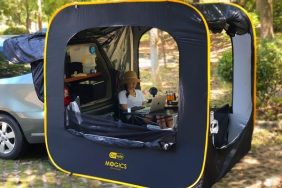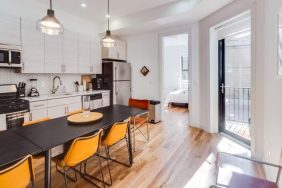Before the before the boldly designed rooms, before Baxter the Boston Terrier greets you, before the digital wall of selfies, the first thing you’ll probably notice at the Radisson RED is the absence of a front desk. Instead of a centralized place to check-in, “creatives” (what RED calls its employees) roam the lobby in T-shirts, jeans, and sneakers, toting iPads to assist guests.
The developers behind the RED brand know their target audience–millennials, and those who think like them–and want to offer a unique experience at a reasonable price point. “Millennials don’t always like to talk to people and there’s a whole DIY component to the brand,” says Rich Flores, vice-president of branding.

Photo: @radissonredbrussels on Instagram.
The hotel’s app is one example. In addition to check in/out functions, keyless entry, and extra pillow or towel requests, the app includes an open forum where guests can communicate with one another and plan outings. Within the hotel, there are levels of security so you can choose what other people can see. When you leave the hotel, that function turns off so you don’t have to worry about being followed.

Photo: @radissonredbrussels on Instagram.
Food is equally instantaneous and available any time of day by placing an order on the app. You then pick it up at the hotel’s OUIBar + KTCHN. Pay for it immediately like a self-checkout at a grocery store or add it to your bill.
In addition to its app-centric environment, RED developers are enthusiastic about offering “shareable moments” for guests, such as at the digital wall in the lobby where you can take a selfie and share it on the hotel’s social media platforms with the push of a button.
Also: Travel: Exploring the Ancient Mysteries of Skara Brae, Scotland
RED hotels are highly localized and have a “discoverability” aspect to them. You don’t just get Budweiser beer, you get cans of Dangerous Man (or similar local brewery brand), and selection rotates. Food menus are global and inspired by food truck culture.
The developers at RED also understand that just because you’re staying at a hotel doesn’t mean you’re not on the clock. The venue is designed to make working at the bar, the restaurant, or in your room equally appealing.
As for the accommodations themselves, the rooms are smaller, more efficient, like studio apartments. They don’t have desks. They’re also paperless; any information you need about the facilities can be gleaned from the app or the TV. Because each room has a unique IP address, you can wirelessly stream or cast from your mobile device to the TV. “It’s no longer whether or not you have Wi-Fi, it’s ‘How good is your bandwith and how many devices can I connect?'” says Flores.
Art is a central focus of the design of RED hotels, which each location representing the local art scene as much as possible; for instance, Brussels has a long legacy of comic book art, so the art design heavily incorporates comic book strips.

Photo: @radissonredbrussels on Instagram.
Creativity isn’t limited to common spaces, either; graffiti by Nick Donalds from Klughaus Gallery in New York adorns the stairwells at RED and there’s artwork all along the passageway between the parking garage and the entrance to the hotel. “I’ve never had the ability to ask a graffiti guy to mess up a white wall,” says Flores. “And you know what? It looks amazing. What’s great about the brand is that it allows you to have this freedom.”

Even the shower tile is artistic. The colors make up images, like a top hat and a cherry in the Brussels location, a nod to surrealist artist René Magritte. The still-in-construction Portland location might feature a Yeti (the bicycle) or a beer stein in the bathroom.
RED doesn’t just want to promote the artists on its walls, however; the brand endeavors to curate an established network of artists and share their work through marketing and social media campaigns, helping new artists rise to notoriety.
Fashion is another influence in the RED’s aesthetic, which explains the creatives’ “un-uniform” that identifies them to guests but still allows them to accessorize (within parameters).
Eventually, Flores wants to see the brand connect with fashion schools and have up-and-coming fashionistas design different series of T-shirts for the “creatives” to wear.
The RED debuts in the U.S. with its Minneapolis location opening on Nov. 16. Portland is scheduled to open in 2017 and Miami in 2018. International locations in Campinas, Brazil, as well as Canada, China, Scotland, and South Africa are also in the works.
Just in case your idea of vacation includes unplugging and making like a Luddite, you’ll still be able to enjoy a stay at the RED. “If you want to take advantage of the technology, it’s there, but we’re not going to push the technology on you,” Flores says. Key cards are still a thing and old-fashioned landline phones are connected in each room. “You don’t need to ever take out your smart phone,” Flores reassures. “And for those of us who are super-techie, you can live in your super-techie world as well.”






